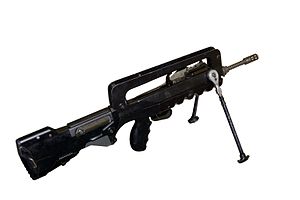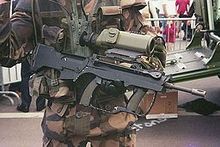FAMAS
| FAMAS | |
|---|---|
 FAMAS F1 | |
| Type | Assault rifle |
| Place of origin | |
| Service history | |
| In service | 1978 - present |
| Used by | France, Djibouti, Gabon, Philippines, Senegal, United Arab Emirates. |
| Wars | First Gulf War |
| Production history | |
| Designer | Paul Tellie |
| Designed | 1967—1971 |
| Manufacturer | Nexter (formerly GIAT Industries) |
| Produced | 1975—present |
| Variants | F1, G1, G2, FAMAS Export, FAMAS Civil, FAMAS Commando |
| Specifications | |
| Mass | Template:Kg to lb (FAMAS F1) Template:Kg to lb (FAMAS G2) |
| Length | 757 mm (29.8 in) / 965 mm (38.0 in) with bayonet |
| Barrel length | 488 mm (19.2 in) |
| Cartridge | 5.56x45mm NATO |
| Action | Lever-delayed blowback |
| Rate of fire | 900-1000 rounds/min (F1) 1000-1100 rounds/min (G2) |
| Muzzle velocity | 960 m (3,149.6 ft)/s (F1) 925 m (3,034.8 ft)/s (G2) |
| Effective firing range | 300 m (F1) 450 m (G2) |
| Feed system | 25-round box magazine (F1) 30-round box magazine (STANAG system) (G2) |
| Sights | Rear aperture fitted with tritium night inserts, front post |
The FAMAS (Fusil d'Assaut de la Manufacture d'Armes de Saint-Étienne: Saint-Étienne arms factory assault rifle) is an assault rifle in bullpup configuration designed and manufactured in France by the Saint-Étienne arms factory, which is a member of the French government-owned Nexter (formerly GIAT Industries) complex. It is the service rifle of the French military.
Development and Production
First french bullpups were developed between 1946 and 1950 at the AME (Atelier Mecanique de Mulhouse) and MAS. Ammunition tested were .30 US Carbine, 7.92x33mm Kurz, 7.65x38mm ( Made by Cartoucherie de Valence) and some other intermediate calibers. France was engaged in Indochina war and was the second contributor and founding member of NATO, the budgets for new types of weapons were cancelled and priority was given to the modernisation of the MAS 49, manufacturing of the SMG MAT 49 and the GPMG AA 52 but 40 different prototypes were developed between 1952 and 1962, most of them in 7.62x51mm NATO. The NATO round was not adapted to a bullpup, none was adopted. MAS began to manufacture under license the H&K G3 and the H&K 33 in the 60's and studies were reactivated to produce a weapon using the new .223/5.56mm round.
Development began in 1967 under the direction of Paul Tellie and the first FAMAS prototype was completed in 1971. French military evaluation of the rifle began in 1972. after many technical problems delayed the adoption of the new rifles, France almost adopted the H&K 33, 1200 pieces were tested by Infantry, Marines, Mechanised and Airborne troops. The 1976 airborne operation in Kolwezi had shown the necessity for a new weapon and in 1977 Manurhin built the SIG 540 under license to equip troops operating overseas in Lebanon and Chad. The French military finally accepted the rifle in 1978 as the standard French combat weapon.
After adoption, the FAMAS F1 effectively replaced the aging MAS-49 semi-automatic rifle. Approximately 400,000 FAMAS F1 assault rifles were produced. The F1 was followed by the G1 that included several minor improvements such as redesigned grips and an enlarged trigger guard. The G1 proved to be an intermediate design, however, as it was soon followed by the FAMAS G2, adopted by the French Navy in 1995. As of late 2006, the French Army has continued with the F1 and a flavour of the F1 fitted with red dot optics, called "FAMAS Infanterie", and is awaiting the FELIN version.
Design

2. Removable stock
3. Cheek rest. Can be reversed for right or left-handed shooter.
4. Mobile assembly and ejection port
5. Pins
6. Bipod
7. Handguard
8. Cocking lever
9. Grenade launcher sight
10. Grenade support
11. Muzzle brake
12. Barrel
13. Fire control selector: Safety, single shot, automatic
14. Trigger
15. Magazine release
16. STANAG magazine
17. Serial number
18. 3-round burst or full automatic selector
19. Sling ring
The FAMAS assault rifle is a bullpup configuration and allows ambidextrous use. The ammunition is stored in a magazine behind the trigger and the receive housing is made of a special steel alloy, rifle furniture is made of fiberglass. The rifle uses a Lever-delayed blowback action, a system employed on the LMG AA 52 derived from the prototypes built during the Army Technical Department tests taking place between WW1 and WW2. Fire rate is controlled by the selector just behind the magazine well. The selector has three settings: safe, single shot, and automatic fire. Another selector, determining whether automatic fire is a three-shot burst of fire (rafale) or fully automatic fire, is located under the housing and behind the magazine.
The FAMAS F1 and G1, the original variants, weigh Template:Kg to lb and were designed to use French-made 25-round magazines with the 5.56x45mm NATO cartridge. These magazines were incompatible with standard NATO weaponry, but the FAMAS G2 uses the STANAG Magazine as used by most other NATO rifles, such as the M16 and SA80. The FAMAS G2 weighs Template:Kg to lb. The G1 and G2 have a large, grip-length triggerguard like a Steyr AUG to allow easy access to the trigger when wearing gloves.
All models of the FAMAS feature a bipod attached on the upper handguard.
Service

The FAMAS first saw service in Chad during operation Manta and again in desert operations in Kuwait during Operation Desert Storm and in other various peacekeeping missions. Operational conditions proved the weapon to be reliable and trustworthy under combat conditions. The FAMAS was affectionately known as clairon ("bugle", because of its shape) amongst French troops in the late 70s-early 80s, but this practice is no longer current. An improved version of the FAMAS is integrated in the Félin system.
Senegal and the United Arab Emirates received a small number of FAMAS rifles (possibly F1) from France, though it was unknown when they received them. Djibouti uses this weapon in its military as the standard infantry weapon. The Philippines also received a limited number and is used by the Philippine National Police Special Action Force. Cambodia's elite units adopted it.
Other images
-
FAMAS F1 with aimpoint (called Famas infanterie)
-
FAMAS F1
-
Trigger guard of the FAMAS in arctic mode, to allow gloves
-
The FAMAS F1 from behind
External links
- Buddy Hinton French FAMAS Picture Collection
- FELIN article, with FAMAS pictured as part of FELIN system
- world.guns.ru
- FAMAS Resource Guide
- Remtek.com




